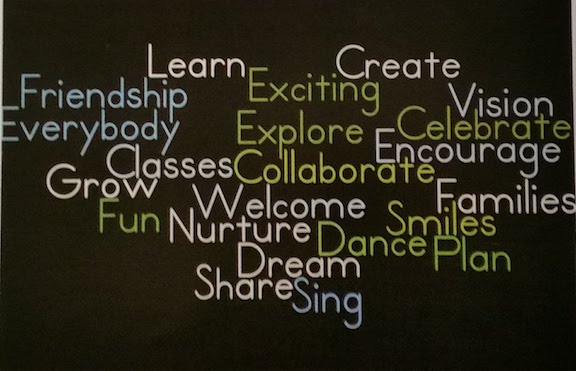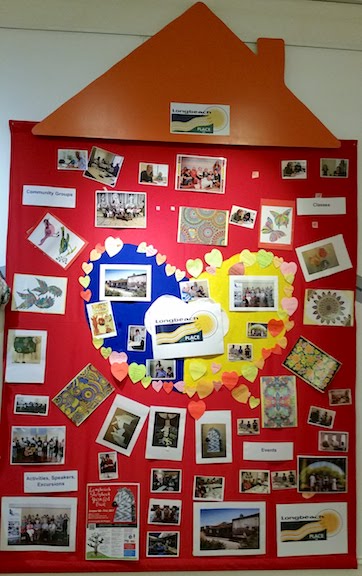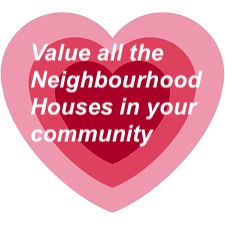
- Chelsea Heights Community Centre captures the essence of neighbourhood houses!
On Monday, under the auspices of Longbeach Place where I teach, I did a creative writing workshop at the Kingston Arts Centre as part of a month-long promotion of community houses in the City of Kingston. This was open to the public for free.
Nine community/neighbourhood houses in the City of Kingston were given display space in the galleries to promote activities under the theme ‘the heart of the community‘.
The promotion also coincided with Volunteer Week. The Council is always keen to encourage people to volunteer and neighbourhood houses are a great place to start a fulfilling journey!
If you are keen to help others, want to share or learn a skill, meet people and help curb your own or their isolation, contribute to the wellbeing and social capital of the community, then there is no better place to start than a neighbourhood house!
What is a Neighbourhood House?
A Neighbourhood House is a not-for-profit local organisation set up to provide social, educational, and recreational activities for a community, in a welcoming, supportive, non-judgemental environment.
Managed by a volunteer committee and some paid administrative staff, it operates with the assistance of volunteers. There is a wealth of accredited and non-accredited courses provided by teachers like myself, but also niche groups set up such as Longbeach Place’s Yarn Art & Craft Storybook Trail, or groups for carers to have time-out, family history buffs, knitting and art enthusiasts… the list is endless.
Neighbourhood Houses have space to host morning teas, conferences, annual general meetings – regular meetings for almost any community group you can imagine. My Mordialloc Writers’ Group met at a neighbourhood house for over 20 years.
Some of the houses are Registered Training Organisations and many are Learn Locals like Longbeach Place, offering VET courses.

Each paper heart on the display board celebrating Longbeach Place was written by a student. In a word or phrase, they described what the neighbourhood house meant to them:
The contributions from the other houses who also used hearts, echoed the recurring sentiments of a safe, friendly environment, nurturing learning and creativity with lots of fun and educational activities.
When Did Neighbourhood Houses Start?
The Neighbourhood House movement began in Victoria in 1973 with the aim of offering people a supportive, non-threatening environment to share skills and mix socially within local communities.
Neighbourhood Houses represent and serve their community. They are accessible drop-in centres that care about social wellbeing, personal and community growth. They often attract and welcome those who feel isolated, neglected, lonely and forgotten or those who have just arrived and want to “fit in”… they provide a learning environment like no other.
The people who attend usually live, study or work within the local area, and courses and activities offered are dictated by the local community and their needs.
This makes each place unique and some develop particular strengths.
Many Houses started with specific groups in mind depending on their locality.
The 1970s – A Time Of Social Change
It was the 70s and the Women’s Liberation Movement was growing. Most community houses grew from women’s involvement and demands. They saw the need for programmes for people with disability, victims of domestic violence, new migrants and multicultural groups, and Aboriginal/ Torres Strait Islanders, women who needed confidence in returning to study or retraining.
Women wanted childcare and playgroups for ‘stay-at-home mums’ and a place for all people to be treated equally regardless of race, religion, gender or ability. They may have left the workforce to have children but still wanted to share their skills or learn new ones as they adapted to motherhood and parenting.
1972 was a watershed in Australian political history – the Federal Labor Government of Gough Whitlam had a strong commitment to community programmes, to women and to children. State Governments followed their lead – times and our culture a’changing.
Federal money released for the first time to fund programs that actively encouraged women back to study and into the workforce by making higher education and training courses free. There were funds for women’s refuges, programs to assist families, and for childcare.
Many women ‘went back to school’ via courses at neighbourhood houses first and gained the confidence and qualifications to enter tertiary studies. Older women whose families were almost grown up returned to study and used the neighbourhood houses to fill gaps in their education but also to develop courses and activities to help others.
Wellbeing And Creativity
Neighbourhood houses help manage social change and prevent social isolation.
The last few years the Men’s Shed Movement has grown out of community houses. The benefits of men having somewhere to go to cope with adjusting to being alone, coping with health issues, retrenchments, early retirement and adjusting to years of extra life expectancy are universally accepted now.
People often discover and develop creative talents in arts and crafts suppressed at school or never given a chance to grow. Creative courses in neighbourhood houses are often the first step for people, at last, being able to show their artistic or writing talents.
Neighbourhood Houses Victoria
Neighbourhood Houses Victoria (NHV) was established in the early 1970s as the peak body for Victorian Neighbourhood Houses and Learning Centres.
- It currently has a membership of over 380 organisations – 90% of the 390 Houses and Centres in the state.
- The mission of the organisation is to support and develop the movement of Neighbourhood Houses and Learning Centres as individual organisations and as a collective.
- This past year they spearheaded a campaign to have the State Government boost funding for the sector.

The Andrews Labor Government is backing our neighbourhood houses as we want to ensure more Victorians have access to the vital employment, training and volunteering services that many neighbourhood houses provide in our local communities across Victoria.
Well done to everyone who campaigned for such a great result.
It is always a relief to have guaranteed funding so that courses can be planned – and with rapidly changing and increasing demographics neighbourhood house managers and committees are kept on their toes!
Writing Creatively At Kingston Arts Centre
I transplanted my usual Monday Class at Longbeach to Moorabbin along with an open invitation to the public.
At one stage, when five of the regulars sent apologies and I was struck by a dreaded winter bug I toyed with following the line of the old song, “let’s call the whole thing off…”
I had no idea what awaited me on Monday but how thrilling to greet three regular students plus some past students and friends – and a lady who said,
“I’ve never written creatively before.”
The two hours disappeared fast along with the chocolate biscuits I brought and the tea and coffee the Arts Centre provided! Yet, we were too busy to have a designated break.
After brief introductions, we did some productive brainstorming and then with heads down the writing began. After each exercise people shared completed sentences, paragraphs, even vignettes to the prompts. Fascinating and vastly different pieces of writing.
I targeted “the senses.” These are often neglected but improve our writing when included. The variety of responses rich and rewarding.
I love writing workshops!
At the conclusion of the exercise on the sense of smell, one participant concluded, ‘I realise I have a limited vocabulary when it comes to describing smells.’
She continued to suggest others do what she does, “when reading I write unusual and interesting words I discover in a notebook. It helps improve my writing. Now, I’ll watch out for how other writers describe smells.’
This is a perfect example of the wonderful feedback and help fellow writers give each other and how writing exercises and sharing in class can improve our writing.
A Personal Story
A few weeks ago, one of my past students from my 2016 class at Mordialloc Neighbourhood House emailed me. English was not her first language and she needed help with a private matter.
It was great to catch up for a coffee and fortunately, I was able to help her. She is an educated, enterprising woman who had been a journalist in Japan but like many who write facts for a living, she wanted to explore creative writing.
She lacked confidence in her own ability and struggled with the nuances of English. In the class, I encouraged her to express herself through poetry.
Her perceptions about adjusting to life in Melbourne and being able to express her feelings about other aspects of her life was a great healing journey but also led to valuable discussions in class.
She blossomed but I’ll let her tell you in her own words what attending a class at a community house meant:
My Writing Class
Naoko
I’ve never really liked classes
I’m often less enthusiastic
preferring to study on my own
I was not a good student in writing class
Yet there are good memories
reminiscent of days visiting relatives –
a bit awkward but feeling secure
In class I remembered the joy of writing
I was accepted for who I was
I made an inspiring Turkish friend
I learned authenticity is the essence of writing
I got to know each classmate’s story
From warm words of condolence
I was encouraged to keep my head high
No matter what I faced
I will take home these great gifts I received
From my writing class at Mordialloc beach
And looking at the past I regret
that I have missed the beauties of life
from being arrogant in classes
I only loved my Mum when I was a kid
And growing up into adulthood
I tended to only love one person at a time
I regret now that I may have missed
the beauties of other people
by being narrow-minded on some occasions
I will take home great gifts about life
received from my writing teacher at Mordialloc beach.
When she left for an extended trip to Japan, Naoko gifted me her poem and a beautiful watercolour she had painted. Gifts I will treasure along with her work published in the class anthology.
The poems and stories of all past students are important to me and when I read their words I hear their voice, imagine them in class… memories I value. Another of my students who has been attending my classes for a long time said exactly the same thing – she reads the anthologies and remembers.
Write your stories – leave a legacy – leave an impression for someone to remember!
Writing In the 21st Century
We are in the digital age and the demands of readers have changed – there are websites, blogs, e-books – all read on a variety of devices with different screens and parameters.
If writers want to reach readers our methods must change – how you adapt is your choice. For many people, the traditional printed paper is still what they want to read and how they want to be published.
There is room for both traditional and digital publishing and whether you write with pen and paper or prefer to tap your laptop or iPad you benefit from regular writing.
Writing classes or workshops can be a first step to discovering not only what you want to write while learning the tools of the craft, but also how you want to be published. More importantly, they can keep you motivated.
Writing courses proliferate online and in bricks and mortar but for convenience and cost, community houses are worth a look. We throw in ambience, friendship and sharing of stories and ideas. We learn from each other and the weekly sessions eliminate the isolation and loneliness many writers suffer.
Community houses provide computer classes too – an introduction and welcome to the digital age that is usually self-paced – again the ambience and friendship are free!
The two places I work have several courses and I can vouch for their excellence at Godfrey Street and Longbeach Place.
And if you want or see a need for a specialised course, put in a suggestion or offer to run it – that’s the beauty of neighbourhood houses! The community owns it and the community is you!
What are you waiting for?
Student, teacher, volunteer, participant – whatever your label there is a place for you in a neighbourhood house – drop in soon!
































A most enjoyable day:)
LikeLiked by 1 person